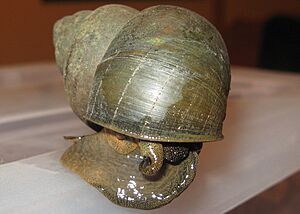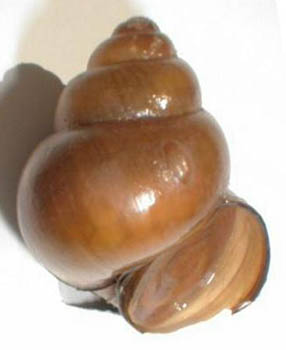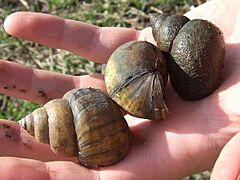Chinese mystery snail facts for kids
Quick facts for kids Chinese mystery snail |
|
|---|---|
 |
|
| A live Chinese mystery snail out of water | |
| Conservation status | |
| Scientific classification | |
| Genus: |
Cipangopaludina
|
| Species: |
chinensis
|
| Synonyms | |
|
|
The Chinese mystery snail, also called the black snail or trapdoor snail (Cipangopaludina chinensis), is a large freshwater snail. It has special parts like gills to breathe underwater and a "trapdoor" called an operculum. This snail is a type of mollusk that lives in water, belonging to the family Viviparidae.
The name "trapdoor snail" comes from its operculum. This is an oval, tough plate that most snails in this group have. When the snail pulls its soft body fully inside its shell, the operculum closes the shell's opening. This helps protect the snail from drying out and from animals that might try to eat it.
Contents
What's in a Name? Understanding Snail Taxonomy
The scientific names for the Chinese mystery snail can be a bit confusing. There are many different names used, especially for populations found outside their native home. Scientists have also debated if Cipangopaludina chinensis malleata and Cipangopaludina japonica are the same species or just different types.
For example, the USGS (United States Geological Survey) sees them as separate species. However, in most North American writings, these snails are called Cipangopaludina. This article uses the name Cipangopaludina to refer to these snails.
What Does a Chinese Mystery Snail Look Like?
Snails in the Cipangopaludina group are easy to spot because of their fairly large, round shells. They also have opercula (trapdoors) with clear circular marks. The snail's shell is shaped like a cone. It is thin but strong, with a sharp tip called an apex.
The shell also has a fairly tall spire (the pointed top part) and a distinct body whorl (the largest, lowest part of the shell). This snail has a small, round umbilicus (a small hole at the center of the shell's base). The spire grows at an angle between 65 and 80 degrees.
Young Chinese mystery snails are light in color. As they grow older, their shells become olive green, greenish brown, brown, or reddish brown. The inside of the shell is white to pale blue. The shell's surface is smooth and shows clear growth lines. A full-grown shell usually has 6 to 7 whorls, which are the turns of the shell.
Chinese mystery snails are large. Their shells are generally about 40 millimetres (1.6 in) tall and 30 millimetres (1.2 in) wide. The largest ones can reach up to 65 millimetres (2.6 in) in height and 40 millimetres (1.6 in) in width. The opening of the shell, called the aperture, is oval-shaped.
Young snails have a clear ridge on their last shell whorl. Their shells also have tiny grooves. Young snails also have a detailed pattern on their outer shell layer, called the periostracum. This includes rows of hairs with tiny hooks.
Unlike apple snails, mystery snails do not have a siphon (a tube for breathing). They give birth to live young. Like all aquatic snails, they have only one pair of tentacles.
Where Do Chinese Mystery Snails Live?
Chinese mystery snails are originally from East Asia. Their native home stretches from the warm areas of Indochina all the way to northern China and Japan, and even eastern Russia. They are very common in China, including the Chinese Loess Plateau.
How Did They Spread? Non-Native Locations
This snail has now made its home in many other parts of the world, especially in North America. It is considered a problematic invasive species in many areas.
In the United States
Chinese mystery snails were first sold in Chinese food markets in San Francisco in the late 1800s. They were found in Boston as early as 1914. It is thought that some snails were released from an aquarium into the Niagara River between 1931 and 1942.
Today, you can find them in many places across the United States. This includes ponds in Connecticut, Massachusetts, and New Hampshire. They are also in rivers like the Potomac in Maryland, the Delaware in New Jersey, and the Hudson and Niagara Rivers in New York. You can also find them in Pennsylvania, Rhode Island, Maine, and Virginia. By 2016, they were known to be in 80 different bodies of water in Minnesota.
In the Great Lakes Region, the first record of Cipangopaludina chinensis malleata was between 1931 and 1942 in the Niagara River, which flows into Lake Ontario. They were found in Lake Erie before 1968. In 1977-1978, Cipangopaludina chinensis was found for the first time in Oneida Lake, which also flows to Lake Ontario. They are now found in the areas around Lake Erie, Lake Ontario, and Lake Michigan.
In Minnesota, it is against the law to release these snails into the wild.
-
A Chinese mystery snail in Naperville, Illinois, USA.
In the United Kingdom
The Chinese mystery snail was first seen in England in a ditch in the Pevensey Levels in Sussex in September 2018. In early 2022, another group was reported in Southampton Common. Experts found them in a boating lake and an ornamental lake there. No one knows for sure how they got there. It might have been from snails released from aquariums or from snails imported for food.
How Do Chinese Mystery Snails Live?
This snail prefers freshwater lakes with soft, muddy, or silty bottoms. They also live in reservoirs, slow-moving rivers, streams, paddy fields, and ponds with aquatic plants. They usually crawl on the bottom or on water plants. They can even survive in still water near septic tanks.
They can live in water with a pH between 6.5 and 8.4. They prefer water temperatures between 20 and 28 degrees Celsius (68-82°F) for growing well. They will go into a resting state, like hibernation, if the water temperature drops below 10-15 degrees Celsius (50-59°F) or rises above 30 degrees Celsius (86°F).
What Do They Eat?
Cipangopaludina chinensis eats both organic (living) and inorganic (non-living) material from the bottom of the water. They also eat algae that grow on the bottom or on plants. They mostly scrape their food. Tiny plant-like organisms called diatoms are probably their most nutritious food source.
In aquariums, these snails mainly eat algae. They are popular in freshwater aquariums because they do not eat fish eggs or plants. They also do not overpopulate the tank. If there is a problem with the water quality, they will close up. This can give aquarium owners a warning that something is wrong before their fish get sick.
Life Cycle of the Snail
This species is ovoviviparous. This means the eggs hatch inside the mother's body, and she gives birth to live, tiny snails. Female snails can live up to 5 years, while males usually live up to 3, or sometimes 4 years.
A female snail can have more than 169 young in her lifetime. She might have up to 102 young in a single group. In eastern North America, females usually carry embryos from May to August. The young are born from June through October in shallow water. In the fall, females move to deeper water for the winter. Females tend to have more young in their 4th and 5th years of life.
Snail Parasites
In its native home, the Chinese mystery snail can carry and spread various parasites. It acts as an intermediate host for several types of trematodes, which are a type of flatworm.
Some of these parasites include Echinocasmus elongatus, Echinocasmus redioduplicatus, and Echinocasmus rugosus. It can also host Echinostoma cinetorchis in Korea. This specific parasite can sometimes infect humans. The snail is also a common host for young echinostomes in the Kinmen islands.
How Do Humans Use Chinese Mystery Snails?
The Chinese mystery snail is one of the main freshwater snails found in Chinese markets. People in most parts of China eat this snail a lot. Its meat is considered tasty and is full of nutrients, with lots of protein and not much fat.
In China, it is also used as a traditional medicine to help treat digestive problems.
Archaeologists have found many of their shells at ancient sites in the Guanzhong Basin of Northwestern China. These shells date back to the Mid-Late Neolithic age. They are the remains of meals eaten by people long ago. The snail meat was mainly eaten as an extra food source.
This snail is also one of the types of rice field snails traditionally eaten in Thailand.




